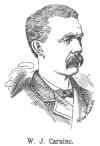the democratic ticket several times but has never been elected to any office.
He is a carpenter by trade.
William Riddle came in 1879 and resides here yet.
William Froly came from Iowa in 1879 and lives here yet.
John Kingdon came in 1880. He lives in the county yet.
J. B. Vansant came here in 1882. He was in the Mexican and civil wars; he lives in the county yet.
Hiram C. Abbott came from Nebraska in 1879. He was sent to the insane asylum in 1888.
Charles H. Starrett was born in Keokuk county, Iowa, December 3, 1856. He attended country district schools in three different counties and five different districts, receiving in thirteen years a little over forty months schooling.
He commenced teaching in Adair county the day after he was 20 years of age, passing a first grade examination.
Determining to secure more education he devoted his whole energy to the accomplishment of that object, enrolling in Monmouth college, Monmouth, Illinois, in January, 1879.
Events entirely out of his control seemed to thwart this plan, and he returned the same winter to Adair county to farm in summer and teach in the winter.
In the spring of 1882 he came to Kansas, reaching Norton county in June expecting to help extend the Central Branch, but upon his arrival found said road run into the ground at Lenora.
He then turned his attention to contract work at wheat farming in McPherson county, Kansas, following this three seasons.
The old idea of more education still being the ruling passion, he entered Salina Normal University in September, 1885, to complete a course in civil engineering, taking up at the same time the commercial course, receiving his commercial diploma in 1886 and his engineering certificate in 1887.
The season of 1888 he spent in Nebraska working a part of the summer with the surveying force of Custer county, making the public roads.
In the fall of 1890 Mr. Starrett settled on the northeast quarter of section 3, township 5, range 25, and has since been trying to make a farm.
In April of 1890 he was appointed county surveyor, holding the office by election and re-election until January, 1894.
On May 30, 1891, he was married, and to this union were born, June 1, 1892, a pair of twins, boys, John D. and Ellis L.
Mr. Starrett has never been a professional teacher though he has always given close attention to schools and school management and has taught several terms.
He believes our school system is the most important subject before the American citizens and next to the temperance cause.
Clark Heath came from New York to Hebran [Hebron], Nebraska, in 1870, and from there to this county in 1881, and settled in Aldine township.
He was married in 1860; they had ten children. His eldest lives in Porland [Portland ?], Oregon; his second daughter, Cora, married Arthur Sheley, they live here.
Mr. Heath's wife died in 1880 and in 1881 he married again [to Emma Sweeley, on
7 Apr 1881], he has one child by this marriage.
 William J. Carnine, the subject of this sketch was born near Burlington, Iowa, May 31, 1847; lived with his parents on the farm until he was about 12 years of age, attending the district school in winter.
At this age he with his parents moved to Mt. Pleasant, Iowa, going to the How schools for one year, then moving to Jefferson county, Indiana.
Two years from this time his mother died. He made his home with an uncle in Dearborn county, working for five dollars a month until the war began, when as often as he could see a recruiting officer and hear the inspiring
William J. Carnine, the subject of this sketch was born near Burlington, Iowa, May 31, 1847; lived with his parents on the farm until he was about 12 years of age, attending the district school in winter.
At this age he with his parents moved to Mt. Pleasant, Iowa, going to the How schools for one year, then moving to Jefferson county, Indiana.
Two years from this time his mother died. He made his home with an uncle in Dearborn county, working for five dollars a month until the war began, when as often as he could see a recruiting officer and hear the inspiring
|